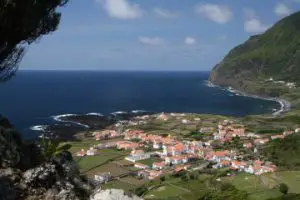Azores film wins at Venice Film Festival
Film shot in São Miguel gets top prize

diariodosacores reports that the film “Lobo e Cão”, by Cláudia Varejão, won the main prize of the “Authors’ Day” competition, parallel to the Venice International Film Festival, the jury announced yesterday.
The jury was chaired by the director Céline Sciamma, with the collaboration of Karel Och, and classified the film as “hypnotizing” and “important”, in a deliberation session transmitted ‘online’.
“Lobo e Cão” was shot in São Miguel, in the Azores, where the director Cláudia Varejão had been in 2016, in artistic residency, at Pico do Refúgio.
That space, located in Rabo de Peixe, gave her “a first entry into the island through a very particular village, with very unique characteristics, very difficult, socially, economically, at various levels”, told the director at the beginning of 2021, in the Azores.
The film “was written from the experience of a number of young people I met here on the island, from my own experience when I was young, which I still have in me – we bring all ages within us,” he said.
According to Cláudia Varejão, the film addresses human issues “that have a very visible and very strong pulse in youth”, namely “sexuality, the desire to transgress – and transgress, whether socially, as the territory itself, therefore, to cross the line of horizon – emotional and affective issues, professional issues, family issues, moral issues”.
“Lobo e Cão”, shot with a local cast, takes on yet another dimension, by showing “what it is like to be young in a territory surrounded by the sea and, in these contexts in particular, contexts with a lot of economic and social difficulties, the idea of achieving other places, other knowledge, to make the dream come true, is more committed”.
Cláudia Varejão is the author of short and feature films, including “Falta-me”, “Luz da Manhã”, “No Escuro do Cinema Descalço os Sapatos”, about the National Ballet Company, and the recent “Ama-san ”, shot in Japan, and “Amor Fati”.
“Lobo e Cão” is a production by Terratreme with French La Belle Affaire.
The Venice Film Festival, which also featured the film “The Bride”, by Sérgio Tréfaut, in the competition of the “Horizons” section, ends today.
Shooting in Sao Miguel
“How do young people inhabit the place, what is the dream space in the life of island youth?” These were the questions that led Cláudia Varejão to return to São Miguel, after, in 2016, she had been on the island in an artist residency, at Pico do Refúgio.
“It is a film that I had in the drawer for a few years, possibly since I was young”, but which, “on the other hand, began to be written here [in São Miguel], during this period of residence and in that first contact with young people. island”, says the filmmaker.
The project “refers to reality and fiction a lot”, she says.
“Wolf and Dog” is a universal film that addresses “all human issues, with their greatest breadth, and which have a very visible and very strong pulse in youth”, she says.
All the questions that are integral to the human being, but that, in youth, are questioned, permanently, and at various levels”.
But it also gains another dimension, by showing “what it is like to be young in a territory surrounded by the sea and, in these contexts in particular, contexts with a lot of economic and social difficulties, the idea of reaching other places, other knowledge, to fulfill the dream , is more committed”.
“The film only stops being written when it goes to shooting”, explains Cláudia Varejão, adding that, “as the ‘castings’ are closed, people also bring more stories. The very structure of the film has to adapt to people’s lives.”
As she has been doing throughout her career, for this project, Cláudia Varejão also starts from the premise of “working with non-actors, therefore, with people from the island”.
“What’s great about working with non-actors is that, since there’s no pre-defined idea of what it’s like to make a film, whether it’s a film written in a tighter way, or a more open film, it’s always a spontaneous experience”, he explains.
To choose the interpreters, “two phases of ‘casting’ were carried out, with a massive participation”, and, “in the first wave, there were almost 800 applications”, for a film that has about 20 roles, says the director.






